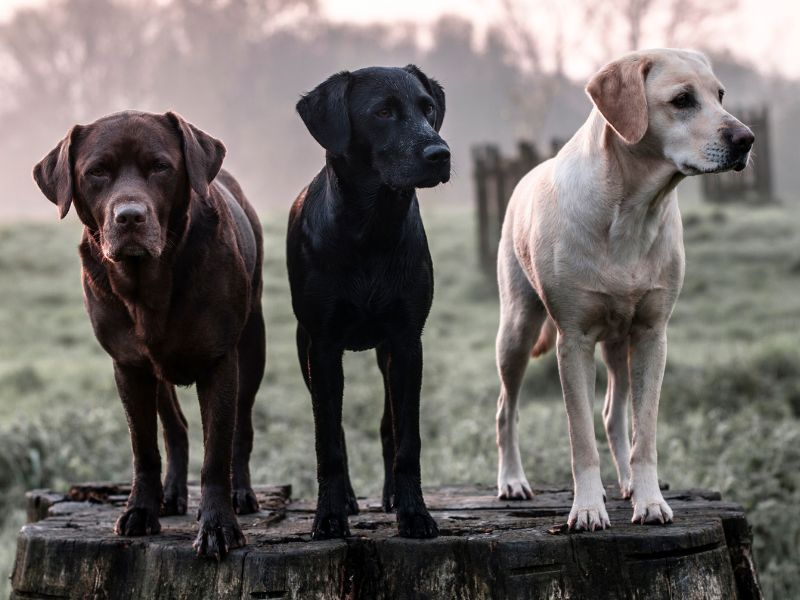
Labrador Retrievers are among the most beloved dog breeds in the world, renowned for their intelligence, ease of training, and amiable disposition. When considering getting a Labrador, many prospective owners wonder which coat color is preferable. The three main coat colors are black, yellow, and chocolate, each with its own unique appeal. While some individuals may have a preference for a specific coat color, it is crucial to remember that all Labradors share the same wonderful traits and characteristics. The difference mainly lies in their outward appearance, with all Labradors possessing the same loving nature and capabilities. Nonetheless, certain stereotypes exist regarding the different Labrador colors and their typical roles. Black Labradors are often associated with gun dog work, yellow Labradors are commonly seen as Guide Dogs for the Blind, and chocolate Labradors are popular as family pets and in the show ring. Ultimately, the decision of which color Labrador is the best fit boils down to personal choice, as every Labrador excels in various roles and is equally affectionate and loyal. In the end, it’s important to remember that all Labrador colors are equally fantastic, and what truly matters is the loving bond and companionship they provide.

Labrador Retrievers come in three standard coat colors – black, chocolate, and yellow. However, there are also uncommon hues like silver, white, and red that can be found. Some may wonder if a Labrador’s coat color has any impact on its behavior, health, or pedigree status. Regardless of their coat color, Labrador Retrievers are known for being great family pets due to their friendly and loyal nature. Their coat color does not play a significant role in their overall temperament. Labradors are typically intelligent, gentle, and easy to train, making them wonderful companions. While there is debate over which color is the best, it ultimately comes down to personal preference. Some may prefer the classic black Labs, while others may be drawn to the yellow, chocolate, or rarer colored ones. In terms of health, there are no major differences between the various coat colors. However, it is important to prioritize responsible breeding practices over selecting for specific colors. A well-bred Labrador from a reputable breeder is more likely to be healthy, regardless of its coat color. The American Kennel Club only recognizes black, yellow, and chocolate Labradors in its breed standards. This means that silver, white, and red Labradors are not accepted for registration. However, these rare colors do not affect a Labrador’s ability to function as a hunting companion, service animal, or family pet. In conclusion, a Labrador’s coat color is primarily a matter of personal preference and does not significantly impact their temperament, health, or abilities. Potential owners should focus on finding a well-bred and healthy Labrador from a reputable breeder rather than getting caught up in debates about coat color.

Fawn Labradors are a distinct and eye-catching variation of the traditional yellow Labrador Retriever. Their beautiful fawn-colored coat sets them apart from the typical yellow Labs, making them a unique choice for dog lovers. Fawn Labs, also known as champagne Labs, exhibit the same lovable and playful characteristics as their yellow counterparts, making them wonderful companions for families and individuals alike. The fawn coloration of these Labs is a result of their genetic makeup, similar to other Labrador colors. Breeders have started to select for this striking fawn hue, creating a niche market for these gorgeous dogs. Fawn Labs can range from a light, creamy fawn to a deeper, richer shade, adding to their individuality and charm. Like all Labradors, Fawn Labs are known for their intelligence and energy levels, making them perfect companions for those who lead active lifestyles. They excel in activities such as fetch, agility training, and obedience exercises, providing mental and physical stimulation to keep them happy and healthy. In terms of health considerations, Fawn Labradors share similar concerns with other Labradors, such as hip and elbow dysplasia. Potential owners should prioritize finding a reputable breeder to ensure their puppy comes from healthy genetic lines and undergo regular health checks to monitor their well-being. Maintaining a Fawn Labrador’s coat is relatively easy, requiring regular brushing to manage shedding and keep their coat shiny and healthy. Owners should also pay attention to their ears’ cleanliness to prevent infections and maintain overall hygiene. In conclusion, Fawn Labradors are a captivating and unique variation of the traditional yellow Labrador Retriever. With their striking fawn coat and lovable personality, these dogs make wonderful companions for active families and individuals who appreciate their beauty and playful nature.

Fawn Labradors stand out with their unique and beautiful shade in the yellow Labrador color spectrum, ranging from light brown to yellowish-brown. Despite their distinct coat color, Fawn Labs share the friendly and sociable temperament typical of Labrador Retrievers. Their intelligence and eagerness to please make them excellent companions and family pets. Regular grooming is crucial for Fawn Labradors to maintain their appearance and manage shedding. Brushing their coat weekly is necessary to prevent matting, remove loose hair, and promote a healthy, shiny coat. While their coat color doesn’t impact their health significantly, like other Labs, they may be prone to health issues like hip dysplasia and obesity, so proper care, exercise, and vet check-ups are essential. Choosing a Labrador color ultimately comes down to personal preference. Labrador Retrievers, regardless of coat color, are known for their loyalty and affection toward their owners. Black Labradors, with their sleek and shiny coat, are a popular choice among Labrador enthusiasts. They excel as gundogs, family pets, companions, and agility dogs. While black Labs are the most common color variation due to how color genes are inherited, their classic appearance and loyal nature make them a favorite choice. Black Labradors exhibit excellent temperament, intelligence, and trainability, making them suitable for families. When selecting a Labrador, focus on temperament, health, and breeder quality. With proper training, a well-bred black Labrador can be an excellent companion. Pippa Mattinson, a Labrador specialist and best-selling author, offers valuable training tips for Labrador owners. She has dedicated over thirty years to breeding, training, and working with Labradors. Pippa’s tips cover various topics, from specific techniques to general advice, benefiting Labradors of all colors. Access her free dog training tips on her website Dogsnet for a tailored approach to Labrador training. Incorporating Pippa’s training guides and tips can help owners strengthen their bond with their Labradors and navigate the training journey with confidence. Chocolate Labradors, like other colors, make fantastic pets with their unique personalities and traits, showcasing the versatility and trainability of Labrador Retrievers.

Deciding on the best Labrador color is a matter of personal preference and lifestyle. Chocolate Labradors, also known as “Chocolate Labs,” have their unique charm with their deep brown coats that were once considered less desirable but are now beloved by many. They may have a slightly shorter lifespan and more health problems compared to other Lab colors, so it’s essential to provide proper care. On the other hand, Silver Labradors, also known as Blue Labradors, have a striking grey-blue coat due to a recessive gene. Despite their unique coloration, they are as friendly and intelligent as other Labs, making them great companions for various activities and roles. When choosing a Labrador color, it’s vital to consider factors such as temperament and compatibility with your lifestyle rather than just appearance. Ultimately, the best Labrador color is the one that fits well with your personality and lifestyle, whether it’s the deep richness of a Chocolate Lab or the striking beauty of a Silver Lab. Whichever color you choose, be prepared to invest time in training, provide proper care, and give them the love and attention they need to thrive as your loyal and devoted companion.

When discussing the most preferred Labrador color, it is crucial to note that personal preference plays a key role. However, we can highlight some common characteristics of the primary Labrador colors: black, yellow, and chocolate. Black Labradors are often associated with gun dog work and are known for their intelligence and easy trainability. Their solid black coat is visually striking and eye-catching. Yellow Labradors are typically cheerful and friendly, making them excellent guide dogs for the visually impaired. Their coat can vary from light cream to a darker golden hue. Chocolate Labradors are praised for their loyalty and loving nature, making them great companions for families. Their brown coat gives them a unique and adorable appearance. Although newer Labrador colors like silver, charcoal, and red have gained recognition, the American Kennel Club officially recognizes black, yellow, and chocolate Labradors. When it comes to choosing a Labrador, it’s important to remember that coat color does not define a dog’s temperament, intelligence, or affection. Factors such as genetics, upbringing, and training play a significant role in a dog’s behavior. Labradors are divided into two types: show and field. Show Labradors, also known as English Labs, are bred for dog shows and companionship. They have a stockier build and a friendly nature, making them ideal family pets. Field Labradors, or American Labs, are bred for hunting and field activities. They have a slimmer build and a strong work ethic, making them excellent working or service dogs. While black Labs have historically been more common in shows and field championships, the color of a Labrador should not be the sole factor in choosing a dog. Consider the type of Labrador that aligns best with your needs and lifestyle. In conclusion, when selecting a Labrador color, it is essential to consider the type of Lab that suits your preferences. Understanding the distinctions between show and field Labradors will help you find the perfect companion, regardless of color preference.

Labradors in need of a loving home can be found in shelters or rescue organizations, where dedicated volunteers work hard to find the perfect match for each dog. These rescue Labradors can come in a variety of coat colors, including black, yellow, chocolate, and even rarer colors like silver or fox red. When adopting a rescue Labrador, potential owners should focus on the dog’s personality and compatibility with their family, rather than just the color of the coat. Research reputable rescue organizations and be prepared to meet specific adoption criteria before bringing home a new furry family member. Labrador Retrievers are known for their gentle and intelligent nature, regardless of their coat color. Each color – black, yellow, and chocolate – has its own unique characteristics and charm. Black Labs are loyal and hard-working, yellow Labs are friendly and cheerful, and chocolate Labs are loyal and loving. Ultimately, the choice of Labrador color comes down to personal preference. Consider your own lifestyle, personality, and aesthetic preferences when choosing a rescue Labrador to bring home. Regardless of color, Labradors are wonderful companions known for their loving, loyal, and intelligent nature. Adopting a rescue Labrador can be a fulfilling and meaningful experience for both the dog and their new family.

Labrador Retrievers are famous for their loving and devoted personalities as well as their wide array of coat colors. The American Kennel Club (AKC) recognizes black, yellow, and chocolate as the main coat colors, but there are also some more uncommon shades like silver, white, and red. A Labrador’s coat color is determined by genetics, with variations within each primary color due to breeding choices or natural genetic variations. For instance, the vibrant red fox Lab comes from breeding darker yellow Labs. Sometimes, a dilute gene can make a typical Labrador color appear lighter, as seen in the unique silver color, which is a variation of the chocolate coat. The silver coat has sparked some debate among Labrador enthusiasts regarding its origins. While coat colors may lead some to assume differences in behavior or health, it’s important to note that these distinctions are mainly cosmetic. A Labrador’s coat color doesn’t necessarily impact its temperament or overall well-being. Factors like breeding practices, environment, and training play a more significant role in a Labrador’s behavior and health. When selecting a Labrador, it’s crucial to focus on these aspects rather than the color of their coat. Responsible breeders prioritize the overall health and temperament of their dogs, ensuring that potential owners bring home a happy and healthy companion. To sum up, Labradors offer a variety of stunning coat colors to suit individual preferences. Remember that these colors don’t determine the health or temperament of these affectionate companions, so prioritize their upbringing and overall well-being before making a choice.


